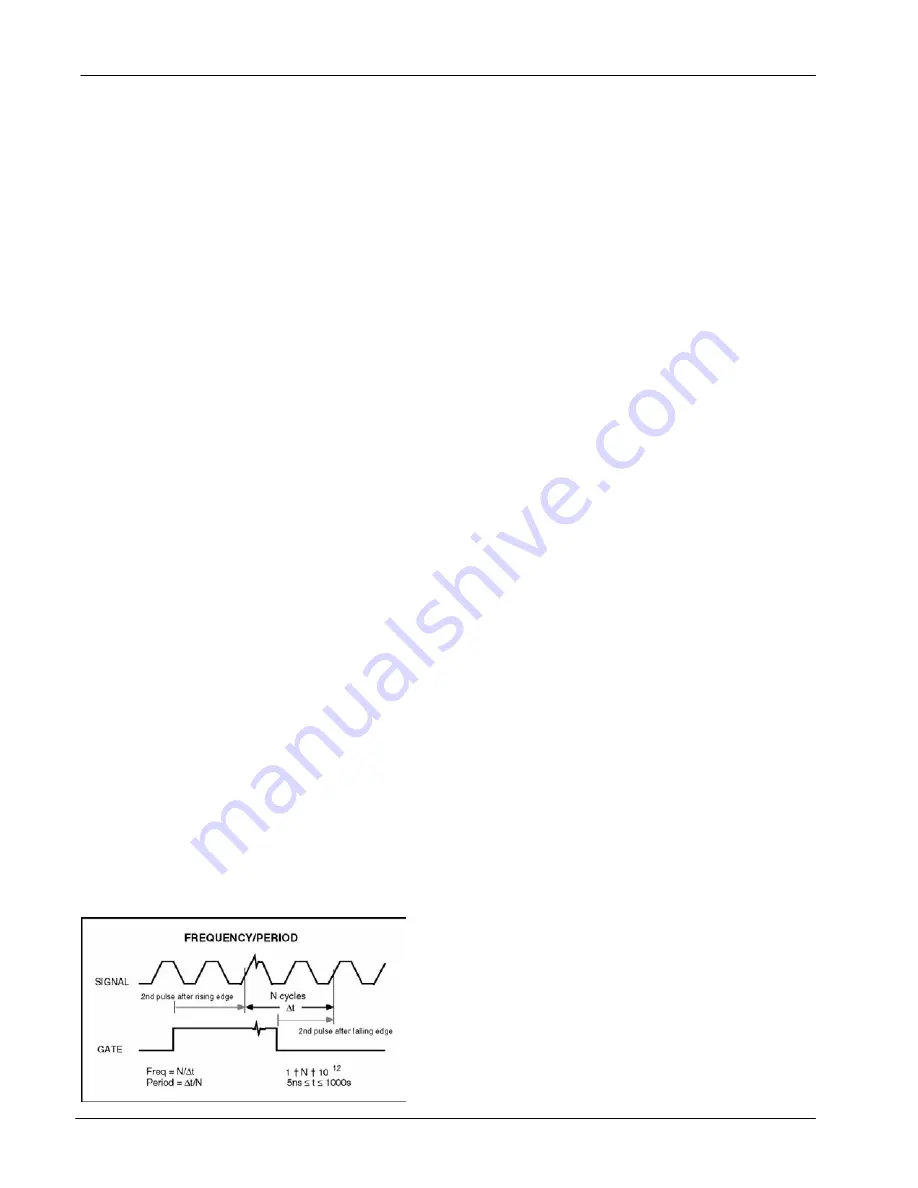
14
Sample Arming
SR620 Universal Time Interval Counter
FREQUENCY
The frequency of either the A or B inputs may be
measured in this mode of operation. The SR620 is
a "reciprocal" frequency counter. That is, it
measures frequency by measuring the time
interval for an integer number of cycles of the
input. The frequency is then equal to (number of
cycles)/(Measured Time). Since there is no
fraction-of-a-cycle error ( as would be seen if the
unit merely counted cycles in a fixed gate ) a
frequency measurement can be made to 11 digits
of resolution in one second. For frequencies
between 0 and 200MHz the SR620's front end
comparators may be directly used. For
frequencies between 200MHz and 1.3GHz the
Ultra High Frequency (UHF) prescalers must be
used.
The number of cycles used in the sample is
determined by the GATE . The instrument will
always measure at least 1 period of the input.
Gates from 1ms to 500s, or EXTernal gates may
be selected from the front panel. The actual gate
time for the internal gates is the gate time set on
the front panel multiplied by the "gate scale" set in
the configuration menu. Thus if one desired a 20s
gate one would set the gate scale to 200 and the
gate time to 0.1s (0.1s x 200 = 20s). If the "gate
scale" is not set to the default of 1 the gate time
led on the front panel will blink. Due to internal
synchronization circuitry, the frequency
measurement starts on the 2nd input edge after
the gate opens and ends on the second input
edge after the gate closes. Thus, a frequency
measurement always requires at least 2 complete
cycles of the input waveform.
The choice of GATE mode is determined mainly
by the desired resolution and measurement
speed. A longer gate results in a higher resolution
measurement with 11 digits obtainable in a one
second sample. The SR620 always adjusts the
number of displayed digits to reflect the
appropriate resolution depending on gate time.
The accuracy of frequency measurements is
determined by the accuracy of time interval
measurements. For very short gates, the
accuracy is determined by the 200ps time interval
accuracy, while for long gates the accuracy is
limited by the accuracy of the timebase.
EXTERNAL gates may be applied to the EXT
input and may range from 5ns to 1000s, although
the SR620 always measures for at least 1 input
period regardless of the gate time. The setup time
for an external gate is about 10 ns. Additionally,
the EXT input may be used to trigger any of the
internal gates (in this mode both the "ext" and the
gate time LED will be on). This is useful , for
example, to synchronize a 0.1s gate to an external
event. Additionally, gates of 1 us to 10 ms may
be scanned using the SR620's scanning facility.
These gates must be externally triggered. The
gate may either be fixed in time relative to the EXT
input, or may be automatically scanned at the end
of a measurement of N samples. If scanned, the
step size is equal to the gate width and the initial
delay may be set between 1 and 50000 gates
times. This scanning ability allows one to make
measurements of frequency as a function of time
from some event, such as the time response of a
VCO to a step change in control voltage.
The RATIO of the frequencies of two inputs will be
displayed if both the A & B source LED are on. It
should be noted that the A and B frequencies are
not measured simultaneously but are measured
on alternate measurement cycles.
PERIOD
Period measurements are done virtually the same
way as frequency measurements, however the
reciprocal of the frequency is reported instead of
the frequency. Gating modes are identical to
those used in the frequency mode.
When both the A and B source lights are on, the
ratio of the periods of signals applied to the A and
B inputs may be displayed. Period ratios may span
from 10-9 to 10+3.
PHASE
The phase between the A and B inputs is
measured in this mode of operation. Two
measurements are actually being done: the period
of the A input and the time interval between the A
and B inputs. For example, suppose the A and B
inputs are both 1 KHz square waves (1000us
period) with the rising edge of B coming 250us
after the rising edge of A. The unit would measure
Содержание SR620
Страница 2: ...SR620 Universal Time Interval Counter...
Страница 6: ...iv Table of Contents SR620 Universal Time Interval Counter...
Страница 8: ...vi Safety and Preparation for Use SR620 Universal Time Interval Counter...
Страница 12: ...x Specifications SR620 Universal Time Interval Counter...
Страница 58: ...42 Programming Commands SR620 Universal Time Interval Counter...
Страница 72: ...56 Programming Examples SR620 Universal Time Interval Counter...
Страница 76: ...60 Troubleshooting Tips SR620 Universal Time Interval Counter...
Страница 82: ...66 Performance Test SR620 Universal Time Interval Counter...
Страница 90: ...74 Calibration Procedure SR620 Universal Time Interval Counter...
Страница 102: ...86 Circuit Description SR620 Universal Time Interval Counter...
Страница 124: ...108 Parts List SR620 Universal Time Interval Counter...
















































